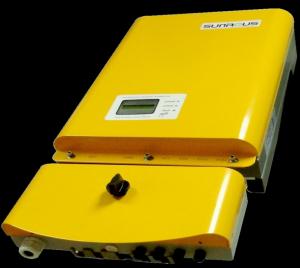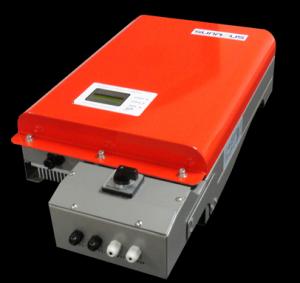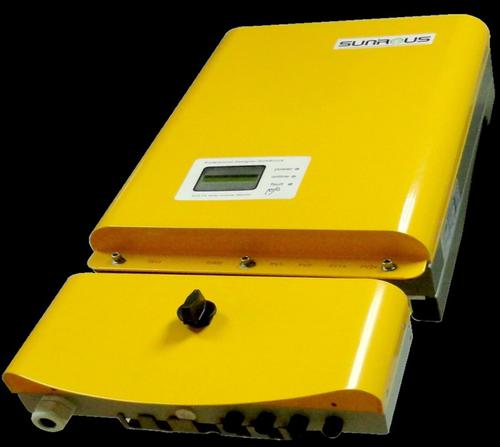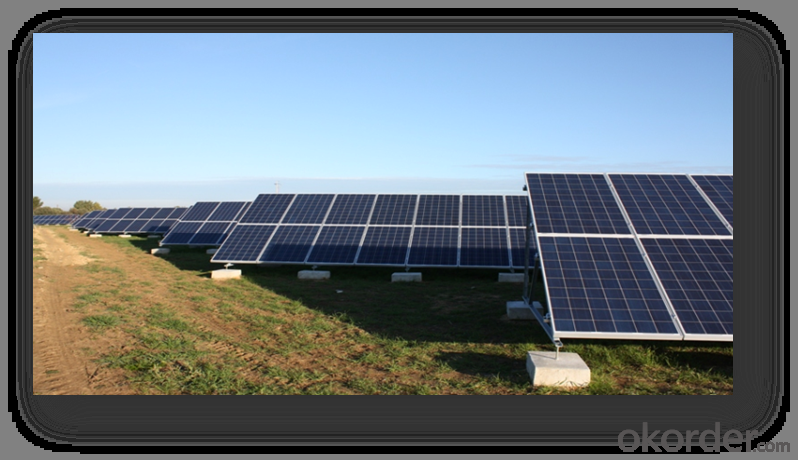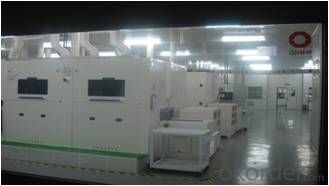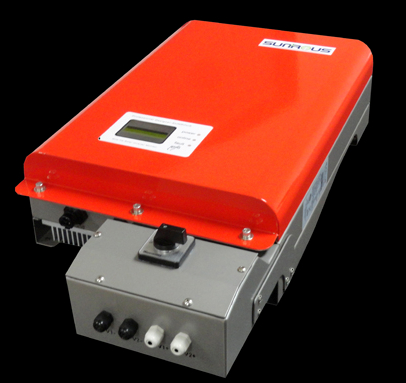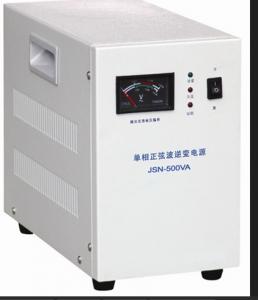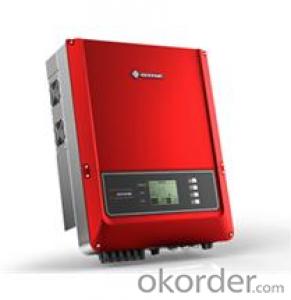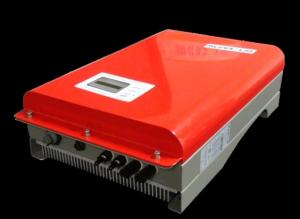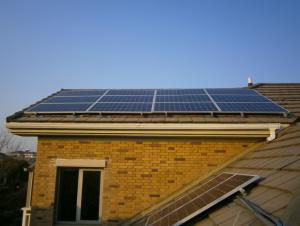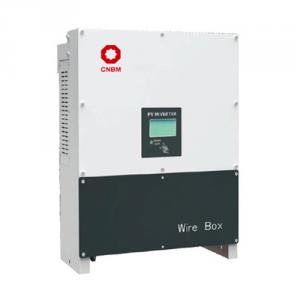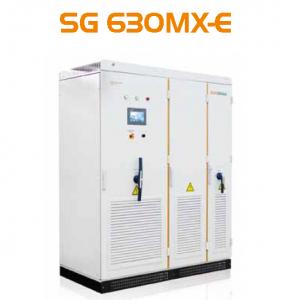1800 Watt High Frequency Transformer Isolation PV Grid-Tied Inverter
- Loading Port:
- Shanghai
- Payment Terms:
- TT or LC
- Min Order Qty:
- 100 mm
- Supply Capability:
- 1000 mm/month
OKorder Service Pledge
OKorder Financial Service
You Might Also Like
characteristics:
5 years warranty
· Sealing stainless steel shell, suitable for indoor or outdoor installation
· High frequency transformer isolation
· The highest effciency achieves 98%
· Wide input Voltage range
· Adopt connectors type cable connection, Easy operation and installation
· Best tracking effciency with OptiTrac MPP control
· operating temperature range -25 ℃ to + 55℃
· High reliability due to complete protection function
· Anti-theft protection
· Plug-in grounding
HF series 1.5kw — 5.0kw
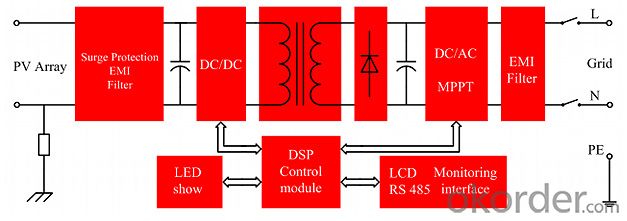
High frequency transformer isolation is the main feature of our production, which make Installation easier due to the reduced weight and higher conversion effciency because of omitting Low frequency transformer. The wide input voltage range from 180 to 600volt gives you extraordinary fexibility for you system design. Not need to set graphic display and RS485 communication system make the devices highly user-friendly.
This product can by multi-level parallel combination for 6kw to 20kw needed any power grade HF series technical parameter.
parameters:
GT1.5-ZX-01/HF | GT2.0-ZX-01/HF | GT2.5-ZX-01/HF | GT3.0-ZX-01/HF | GT4.0-ZX-01/HF | GT5.0-ZX-01/HF | |
Input(DC) | ||||||
Max.DC Power | 1600W | 2100W | 2650W | 3150W | 4200W | 5200W |
Max.DC Voltage | 600V | |||||
PV Voltage range, MPPT | 150V ~ 550V | 150V ~ 550V | ||||
Max.input current | 10.0A | 14.0A | 16.0A | 20.0A | 25.0A | 30.0A |
Number of MPP trackers | 1 | |||||
Max.number of strings (parallel) | 1 | 1 | 2 | 2 | 3 | 3 |
Output(AC) | ||||||
Nominal AC power / | 1500W | 2000W | 2500W | 3000W | 4000W | 5000W |
Max.output current | 13.0A/7.0A | 17.0A/9.0A | 21.0A/12.0A | 25.0A/14.0A | 21.0A | 30.0A |
Nominal AC Voltage / range | 102-138Vac/180-264Vac | 180-270Vac | ||||
AC grid frequency / range | 47.5-51.5Hz / 59.3-60.5Hz | |||||
Power factor at rated power | 1 | |||||
THD | < 3% | |||||
AC connection | Single-phase | |||||
Efficiency | ||||||
Max. efficiency/Californian efficiency | > 98.0% / > 97.0% | |||||
MPP adaptation efficiency | > 99.0% | |||||
Protection devices | ||||||
DC reverse polarity protection | √ | |||||
AC short-circuit protection | √ | |||||
Ground fault monitoring | √ | |||||
Grid monitoring | √ | |||||
Output Transient Voltage Suppression | √ | |||||
Over load | √ | |||||
Anti-islanding | √ | |||||
General data | ||||||
Dimensions (W/ H / D) in mm | 350 / 560 / 160 | 370 / 540 / 185 | ||||
Weight(Kg) | 16 | 19 | 23 | |||
Operating temperature range | -25 ~ +60℃ | |||||
Storage temperature range | -40 ~ +70℃ | |||||
Ambient humidity | 0 ~ 100% | |||||
Consumption (night) | < 0.5W | |||||
Topology | HF-transformer galvanic isolation | |||||
Cooling concept | Convection | |||||
Enclosure type | IP65 / NEMA 3R | |||||
Features | ||||||
DC connection: PV special connector | √ | |||||
AC connection: connector | √ | |||||
LCD display & Backlit | √ | |||||
LED display | √ | |||||
Interfaces: RS485 | √ | |||||
Warranty: 10 years | √ | |||||
Certificates & approvals | G83 / G59 / TUV / SAA / ETL / JET/ CE | |||||
certificates:
The Australian SAA certification
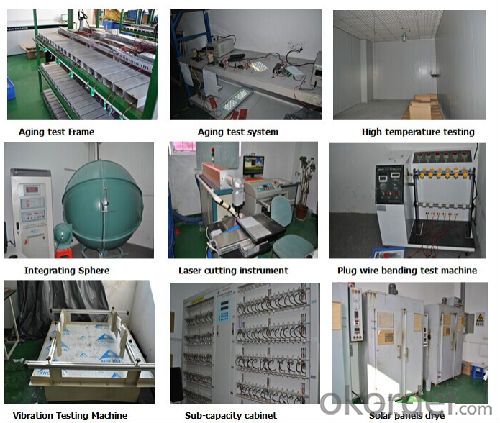
Q1 : What is you advantages
A1:
a).We are professional ups manufacturer for more than ten years and we have these staffs with rich
production and R&D
b) Excellent workers and skilled engineers
c).Our aims are to provide every customer high quality, reasonable price and excellent
service.
d)we can guarantee to send the goods on time. And also accept any transportation ways that
you require
Q2 : How do you control the production quality
A2:
a) For materials, we have IQC departments and the IQC testing follow MIL-STD-105E standard
b) in production have 4 times function testing
c) all of our products with 100% burn-in testing
d) 100% QC testing before delivery
Q3 : Do you accept OEM/ODM?
A3 : ODM&OEM are warmly welcomed !!!
- Q: How does a solar inverter communicate with other components of a solar power system?
- A solar inverter communicates with other components of a solar power system through wired or wireless connections. It typically uses communication protocols such as Modbus, CAN bus, or Ethernet to exchange data with devices such as solar panels, batteries, energy meters, and monitoring systems. This communication enables the inverter to receive information about the solar panel's output, battery status, and energy consumption, allowing it to optimize power generation and manage energy flow within the system.
- Q: How does a solar inverter handle voltage drop?
- A solar inverter handles voltage drop by continuously monitoring the voltage levels from the solar panels. If it detects a drop in voltage, it adjusts its internal voltage regulation mechanisms to maintain a stable output voltage. This ensures that the inverter can efficiently convert the incoming DC power from the solar panels into usable AC power without any significant loss or disruption caused by voltage fluctuations.
- Q: Can a solar inverter be used in mobile or portable solar systems?
- Yes, a solar inverter can be used in mobile or portable solar systems. Solar inverters are essential components that convert the direct current (DC) generated by solar panels into alternating current (AC) that can be used to power various devices. They are designed to be adaptable and can be used in a wide range of applications, including mobile or portable solar systems. This allows individuals to harness solar energy and use it to power their devices wherever they go, making it a convenient and sustainable solution for on-the-go power needs.
- Q: What is the maximum number of AC outputs in a solar inverter?
- The maximum number of AC outputs in a solar inverter can vary depending on the specific model and design, but typically it ranges from one to three AC outputs.
- Q: What is the maximum power capacity that a solar inverter can handle?
- The maximum power capacity that a solar inverter can handle depends on its specific model and specifications. In general, solar inverters can handle power capacities ranging from a few hundred watts to several megawatts, catering to various residential, commercial, and utility-scale solar installations.
- Q: What maintenance is required for a solar inverter?
- Regular maintenance for a solar inverter typically includes visual inspections, cleaning, and ensuring proper ventilation. It is also important to monitor and clean the solar panels to prevent any shading or debris that could affect the overall performance of the inverter. Additionally, checking and tightening all electrical connections, as well as updating the firmware and software, may be necessary to ensure optimal functionality.
- Q: Can a solar inverter be used with a solar-powered disaster relief system?
- Yes, a solar inverter can be used with a solar-powered disaster relief system. A solar inverter is an essential component of a solar power system, converting the direct current (DC) generated by solar panels into alternating current (AC) that can be used to power electrical devices. In a disaster relief system, solar panels capture sunlight and convert it into electricity, which is then fed into the inverter to produce usable AC power for various relief operations such as lighting, charging devices, or running essential equipment. Thus, a solar inverter is crucial in enabling the functionality and effectiveness of a solar-powered disaster relief system.
- Q: How do you size a solar inverter for a solar power system?
- To size a solar inverter for a solar power system, you need to consider the maximum power output of your solar panels. This can be determined by looking at the wattage rating of each panel and multiplying it by the number of panels in your system. Once you have the total power output, you should choose an inverter with a capacity slightly higher than the calculated value to allow for any future expansions or increases in power generation. Additionally, it is important to consider the type of inverter, such as string, micro, or hybrid, based on the specific requirements and constraints of your solar power system.
- Q: Can a solar inverter be repaired or replaced if it malfunctions?
- Yes, a solar inverter can be repaired or replaced if it malfunctions. In many cases, minor issues can be resolved through repairs, such as replacing faulty components or fixing wiring problems. However, if the malfunction is severe or the inverter is beyond repair, it may need to be replaced with a new one.
- Q: What is the role of a solar inverter in maintaining system stability?
- The role of a solar inverter in maintaining system stability is to convert the direct current (DC) electricity generated by solar panels into alternating current (AC) electricity that can be used in homes or fed back into the electrical grid. The inverter also ensures that the output voltage and frequency of the AC electricity are within acceptable limits, allowing for seamless integration with the existing power grid. By regulating and stabilizing the electricity flow, the solar inverter helps maintain the overall stability and reliability of the solar power system.
Send your message to us
1800 Watt High Frequency Transformer Isolation PV Grid-Tied Inverter
- Loading Port:
- Shanghai
- Payment Terms:
- TT or LC
- Min Order Qty:
- 100 mm
- Supply Capability:
- 1000 mm/month
OKorder Service Pledge
OKorder Financial Service
Similar products
Hot products
Hot Searches
Related keywords
